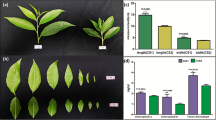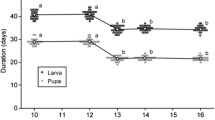Abstract
Apolygus lucorum (Heteroptera: Miridae), an important herbivore feeding on a broad range of cultivated and wild plants, always shows a strong preference for flowering host plants. In a prior study, we found A. lucorum fecundity to be higher on flowering plants than on plants still at the vegetative stage. This led us to hypothesize that ovarian development and vitellogenin (Vg) expression in A. lucorum, which are highly correlated with its fecundity, might respond positively to the presence of host plant flowers as food. In this study, two types of plant foods, i.e., cotton terminals and flowers, and cotton terminals only without flowers, were examined. Adult females on terminals with flowers had higher ovarian development levels than those of similar stage held on terminals without flowers. Moreover, adults on terminals with flowers had more follicles per ovary throughout adult life than those held on terminals without flowers, and the length of the most developed ovariole of the former treatment was significantly longer than that of the latter diet. Use of qRT-PCR showed that the expression level of Vg was significantly higher in adults raised on a diet with flowers compared with those raised on the diet without flowers. These results suggest that host plant flowers significantly facilitate ovarian development and Vg gene expression of A. lucorum adults.




Similar content being viewed by others
References
Bong LJ, Neoh KB, Lee CY, Jaal Z (2014) Effect of diet quality on survival and reproduction of adult Paederus fuscipes (Coleoptera: Staphylinidae). J Med Entomol 51:752–759
Bownes M, Reid G (1990) The role of the ovary and nutritional signals in the regulation of fat body yolk protein gene expression in Drosophila melanogaster. J Insect Physiol 36:471–479
Cabrera Cordon AR, Shirk PD, Duehl AJ, Evans JD, Teal PEA (2013) Variable induction of vitellogenin genes in the varroa mite, Varroa destructor (Anderson & Trueman), by the honeybee, Apis mellifera L., host and its environment. Insect Mol Biol 22:88–103
Chu HF, Meng HL (1958) Studies on three species of cotton plant bugs, Adelphocoris taeniophorus Reuter, A. lineolatus (Goeze), and Lygus lucorum Meyer-Dür (Hemiptera: Miridae). Acta Entomol Sin 8:97–118
Dong SZ, Guo JY, Ye GY, Hu C (2008) Effect of adult nutrition and mating on ovarian development and vitellogenesis in the endoparasitoid, Pteromalus puparum (Hymenoptera: Pteromalidae). Acta Phytophyl Sin 5:193–198
Dong JW, Pan HS, Lu YH, Yang YZ (2013) Nymphal performance correlated with adult preference for flowering host plants in a polyphagous mirid bug, Apolygus lucorum (Heteroptera: Miridae). Arthropod Plant Interact 7:83–91
Fleischer SJ, Gaylor MJ (1987) Seasonal abundance of Lygus lineolaris (Heteroptera: Miridae) and selected predators in early season uncultivated hosts: Implications for managing movement into cotton. Environ Entomol 16:379–389
Groot AT, van der Wal E, Schuurman A, Visser JH, Blommers LHM, van Beek TA (1998) Copulation behavior of Lygocoris pabulinus under laboratory conditions. Entomol Exp Appl 88:219–228
Jiang YY, Lu YH, Zeng J (2015) Forecast and management of mirid bugs in multiple agroecosytems of China. China Agriculture Press, Beijing
Kawakami Y, Goto SG, Ito K, Numata H (2009) Suppression of ovarian development and vitellogenin gene expression in the adult diapause of the two-spotted spider mite Tetranychus urticae. J Insect Physiol 55:70–77
Li WJ, Yuan W, Zhao XC, Wu KM (2016) Molecular cloning and expression profile of Vitellogenin in relation to tissue and food source in Apolygus lucorum (Hemuptera: Miridae). Ann Entomol Soc Am. doi:10.1093/aesa/saw005
Livak KJ, Schmittgen TD (2001) Analysis of relative gene expression data using real-time quantitative PCR and the 2−ΔΔCT method. Methods 25:402–408
Lu YH, Wu KM (2008) Biology and control of cotton mirids. Golden Shield Press, Beijing
Lu YH, Wu KM, Cai XM, Liu YQ (2008) A rearing method for mirids using the green bean, Phaseolus vulgaris in the laboratory. Acta Phytophyl Sin 35:251–269
Lu YH, Wu KM, Jiang YY, Xia B, Li P, Feng HQ, Wyckhuys KAG, Guo YY (2010) Mirid bug outbreaks in multiple crops correlated with wide-scale adoption of Bt cotton in China. Science 328:1151–1154
Lu K, Shu YH, Zhou JL, Zhang XY, Zhang XY, Chen MX, Yao Q, Zhou Q, Zhang WQ (2015) Molecular characterization and RNA interference analysis of vitellogenin receptor from Nilaparvata lugens (Stål). J Insect Physiol 73:20–29
Murphy DD, Launer AE, Ehrlich PR (1983) The role of adult feeding in egg production and population dynamics of the checkerspot butterfly Euphydrya seditha. Oecologia 56:257–263
Pan HS, Lu YH, Wyckhuys KAG, Wu KM (2013) Preference of a polyphagous mirid bug, Apolygus lucorum (Meyer-Dür) for flowering host plants. PLoS ONE 8:e68980
Papaj DR (2000) Ovarian dynamics and host use. Annu Rev Entomol 45:423–448
Sappington TW, Raikhel AS (1998) Molecular characteristics of insect vitellogenins and vitellogenin receptors. Insect Biochem Mol Biol 28:277–300
Tufail M, Takeda M (2008) Molecular characteristics of insect vitellogenins. J Insect Physiol 54:1447–1458
Tufail M, Takeda M (2009) Insect vitellogenin/lipophorin receptors: molecular structures, role in oogenesis, and regulatory mechanisms. J Insect Physiol 55:87–103
Veerana M, Kubera A, Ngernsiri L (2014) Analysis of the vitellogenin gene of rice moth, Corcyra cephalonica Stainton. Arch Insect Biochem 87:126–147
Wäckers FL, Romeis J, Van Rijn PCJ (2007) Nectar and pollen feeding by insect herbivores and implications for multitrophic interactions. Annu Rev Entomol 52:301–323
Wheeler D (1996) The role of nourishment in oogenesis. Annu Rev Entomol 41:407–431
Wheeler AG Jr (2001) Biology of the plant bugs (Hemiptera: Miridae). Cornell University Press, Ithaca
Womack CL, Schuster MF (1987) Host plants of the tarnished plant bug (Heteroptera: Miridae) in the northern blackland prairies of Texas. Environ Entomol 16:1266–1272
Wu KM, Lu YH, Feng HQ, Jiang YY, Zhao JZ (2008) Suppression of cotton bollworm in multiple crops in China in areas with Bt toxin-containing cotton. Science 321:1676–1678
Yuan W, Li WJ, Li YH, Wu KM (2013) Combination of plant and insect eggs as food sources facilitates ovarian development in an omnivorous bug Apolygus lucorum (Hemiptera: Miridae). J Econ Entomol 106:1200–1208
Zhao YL, Li DS, Zhang M, Chen W, Zhang GR (2014) Food source affects the expression of vitellogenin and fecundity of a biological control agent, Neoseiulus cucumeris. Exp Appl Acarol 63:333–347
Acknowledgments
This study was financially supported by the National Basic Research Program of China (No. 2012CB114104) and the National Natural Science Funds of China (Nos. 31222046 and 31321004).
Author information
Authors and Affiliations
Corresponding author
Additional information
Handling Editor: Heikki Hokkanen.
Rights and permissions
About this article
Cite this article
Zhang, W., Liu, B., Liang, G. et al. Flowers promote ovarian development and vitellogenin gene expression in Apolygus lucorum (Heteroptera: Miridae). Arthropod-Plant Interactions 10, 113–119 (2016). https://doi.org/10.1007/s11829-016-9420-5
Received:
Accepted:
Published:
Issue Date:
DOI: https://doi.org/10.1007/s11829-016-9420-5




